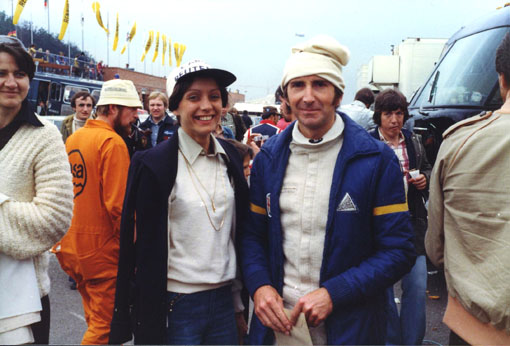

1977 BELGIAN GRAND PRIX
ZOLDER
John Watson, posing with Marie-Jeanne.
Madly enthusiastic about motor racing from an early age - his father, Marshall Watson, won the first saloon car race to be held in Ireland at the wheel of a Citroen Light 15 - John's rise from club racing to international Grand Prix stardom proved to be a gruelling, and at times frustrating, career path. John's father was a successful Belfast motor trader who bankrolled his son's racing up to the level of F2, in which he competed for three years (1969 to 1971) in family owned Lotus and Brabham machinery.
By 1973 he was ready for F1, making his Championship debut in the British GP at Silverstone where he drove a Brabham BT37. He drove for the Hexagon Brabham F1 team, backed by prosperous Highgate motor trader, Paul Michaels, throughout 1974 and scoring his first Championship point with a sixth place at Monaco. In 1975 he briefly drove for Team Surtees before switching to the new F1 operation established by American millionaire Roger Penske, taking the place of his original driver Mark Donohue who had died of brain injuries sustained when a tyre failure caused him to crash during the race morning warm-up prior to the 1975 Austrian GP. Watson would earn the team a superb victory in the following year's Austrian Grand Prix, forfeiting his beard in a wager with Penske, the millionaire Ivy League team boss disapproving of such appendages!
After Penske withdrew from F1 at the end of the 1976 season, Watson switched to the Brabham-Alfa squad for two seasons during which he was unable to reproduce that winning form. In 1979 he moved to McLaren as team leader when the position fell vacant after Ronnie Peterson's death at Monza the previous September, but his high hopes were dashed when the new McLaren M28 proved disastrously uncompetitive. John's self-confidence was also somewhat undermined by the not-always sympathetic strictures of team manager, Teddy Mayer. Only when Ron Dennis and his colleague John Barnard became involved with McLaren did the team's fortunes pick up dramatically, and Watson proved to be the initial beneficiary of this upsurge when he won the 1981 British Grand Prix at Silverstone in the Barnard-designed carbon fibre chassis McLaren MP4. In 1982 and 1983, Watson found himself psychologically overshadowed by the reappearance of his former Brabham team-mate Niki Lauda as his partner in the McLaren line-up. Nevertheless, John drove outstandingly to win the 1982 Belgian and Detroit GPs and the 1983 Long Beach event before the suddenly available Alain Prost replaced him in the McLaren F1 line-up for 1984.
Apart from a single guest outing for McLaren at Brands Hatch in 1985, that was the end of Watson's F1 career. It was a shame, for although John could vary alarmingly, he was a natural driver with inborn skill. A perfectionist in the complicated business of 'setting up' a chassis, if he was unhappy about his machinery, then he was frequently less than inspired. But when he hit top form he could display World Championship potential. As an individual, his personality remained unspoiled throughout his F1 career and he remains as congenial company now as he was in the fledgling days of his single-seater apprenticeship.
Since retiring from Formula 1, Watson has raced for the Jaguar and Toyota sports car teams, and gave Eddie Jordan's new F1 challenger its first track test at the start of 1991. He now concentrates on the Silverstone-based John Watson Performance Driving Centre, as well as commentating on Grand Prix for the Eurosport satellite TV channel.